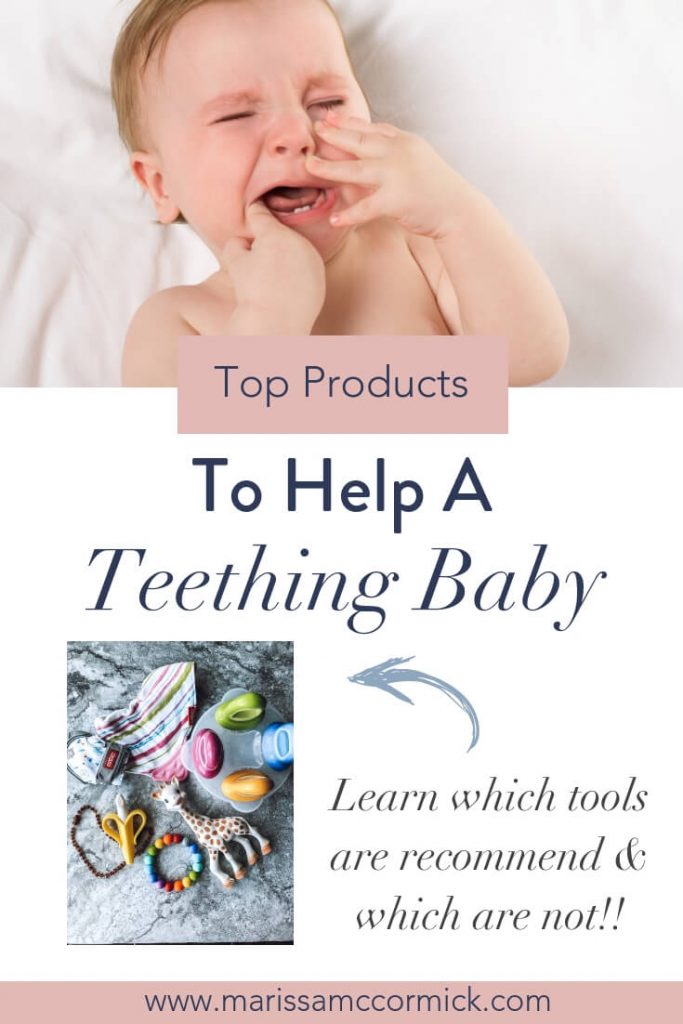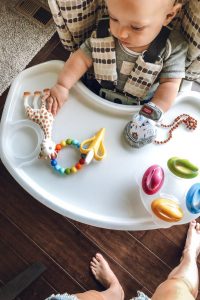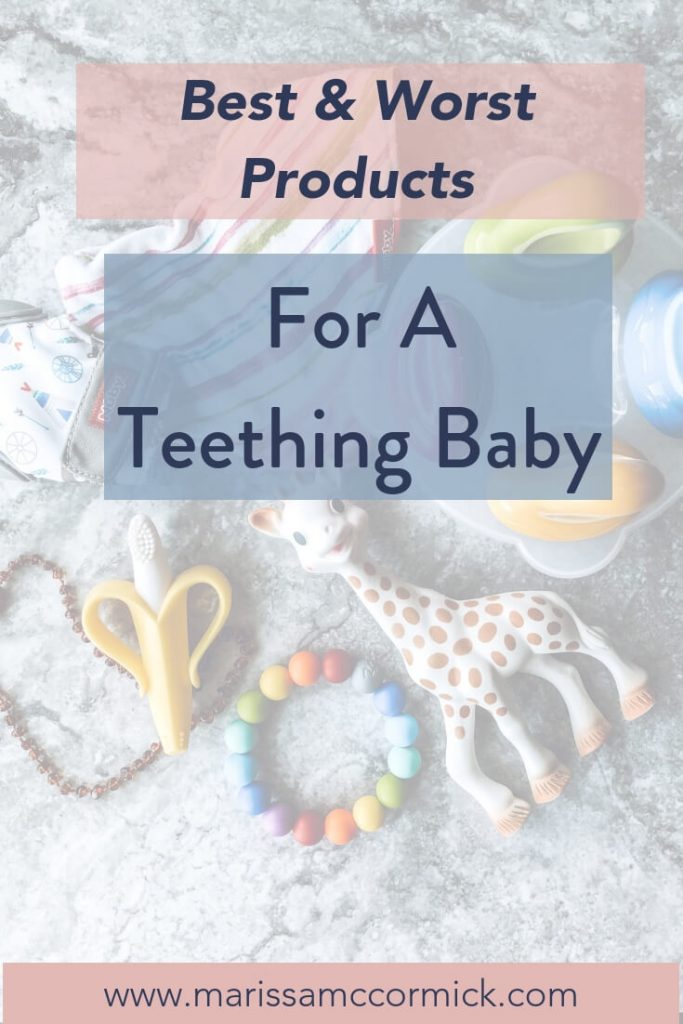The Best & Worst Baby Products For Teething
If your little one is teething, there’s a good chance you’re in desperate need of some tools & tips to help ease baby’s pain & fussiness!

It’s important to know what is recommended for teething & equally important what is NOT.
We are going through a teething frenzy right now with our son as I write this, and it sucks! There’s just not a whole ton anyone can do about those pesky little teeth popping, but we can help distract baby & soothe the gums!

To be honest, when I first wrote this post, I didn’t think much “research” needed to be done. I, like many other moms, trusted the safety & convenience of products marketed for teething. Thanks to another mama, I quickly learned I needed to do more research!
Signs of Teething:
- Drooling
- Swollen gums
- Elevated temperature – most often not high enough to be considered a fever (>100.4 degrees Fahrenheit)
- Fussiness/irritability
- Fingers, fists in mouth
- Most babies develop teething between 6-12 months. However, teething can begin as early as 2-4 months! (Read more).
How To Help:
- Rub Baby’s Gums: gently rub infant’s gums with a clean finger.
- Try a Teething Ring: provide a teething ring made of firm rubber to chew on. Make sure the teething ring is not frozen, because if the object is too hard, it can hurt baby’s gums.
- Keep It Cool: try a chilled/refrigerated teething ring to provide cooling relief. If your baby is eating solid foods, cold foods like carrot sticks, celery sticks, or even baby “popsicles” can help soothe sore gums. Remember to always keep a close eye on your baby with any sort of teething tool to avoid accidental choking.
- Medicine: if your baby is clearly uncomfortable, talk with your pediatrician about giving a weight-appropriate dose of acetaminophen (e.g. Tylenol). or if over 6 months, ibuprofen (e.g. Advil, Motrin).
Lastly, when searching for teething products, look for BPA-free and food-grade silicone/natural rubber. If possible, look for toys that comply with by CPSC product safety regulations (not always easy to find).
Here are a few “teething-friendly” products we’ve tried:
A simple, rubber teething ring. Certified non-toxic and FDA-compliant!
Since teething babies always seem to have hands in their mouths, a teething mitten may help relieve sore gums. Bonus that this one makes a crinkle noise to stimulate baby’s senses!
Freezer, reusable, “popsicle!” Fill will breast milk or formula if baby has not yet started solid foods. As they get older, you can easily add blended fruit or veggies! It’s a no-mess cold Popsicle used for a soothing treat!
Teething Banana! Silicone rubber that’s great for sore gums & dual-acts as a starter toothbrush. We love this product!
With teething comes drool, lots of drool! Save baby’s clothes with a drool bib. Plus is has a small teether chew at the tip. *Do not leave baby unattended with a bib on, or anything around their necks.
Soffie the giraffe is one of our favorite chew toys!! Both my babies have LOVED this product.
Teething Products To Avoid.
- Teething bracelets, necklaces or or other jewelry
Both the American Academy of Pediatrics & U.S. Food and Drug Administration (FDA) warn against teething jewelry for risks of choking, strangulation, injury to the mouth and infection. (Read more).
Amber teething beads have become popular. I’ll be the first to admit I even tried them with my daughter after hearing from a friend they worked great (I was not aware of the hazards at the time & thankfully nothing serious happened!). In addition to suffocation concerns, amber teething necklaces contain succinic acid, which may be released into an infant’s blood stream in unknown quantities. Makers of these products often claim succinic acid acts as an anti-inflammatory and relieves teething and joint pain. There is no scientific evidence to support these claims, and the FDA has not evaluated the claims for safety or effectiveness, and recommends parents not use these products.
- Teething toys with beads, other small parts,or filled with liquid.
Similar to teething jewelry, any rings or toys with beads, or small parts are a choking hazard. Fluid-filled teethers may puncture and leak, posing a potential choking hazard or leak contain contaminated liquid.
- Hard or sharp toys
Toy that are too hard or have sharp edges can hurt or harm baby’s gums.
- Teething gels, sprays, lozenges or other homeopathic remedies.
The FDA warns against using any sort of topical medication to treat teething pain in children, including prescription or over the counter creams (OTC) and gels. They offer little to no benefit and are associated with serious risk. Benzocaine is the active ingredient in several OTC oral health care products such as Baby Orajel. These products should not be used for teething because they can be dangerous and are not useful because they wash out of a baby’s mouth within minutes. (Read more).
I found that it helps to have a variety of “tools in the teething toolbox” because each baby is different & each tooth can be different! Stick with the recommended tooling tools & tips, and just say no to the risky ones!
Good luck 🙂 And remember, this too shall pass!
This is not an exhaustive list of the research. I encourage you to continue reading, research & further discussing with your pediatrician.

*This post contains links to Amazon.com. As an Amazon Associate I earn from qualifying purchases.
References:
https://www.fda.gov/consumers/consumer-updates/safely-soothing-teething-pain-and-sensory-needs-babies-and-older-children

Be the first to comment